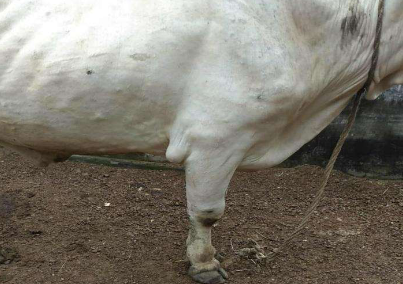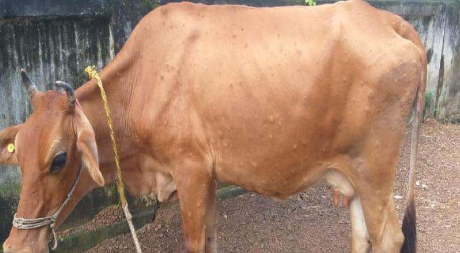Advisory on Lumpy Skin Disease
Advisory on Lumpy Skin Disease
Lumpy skin disease (LSD) is an infectious viral disease of cattle and buffaloes caused by the Capripox virus of family Poxviridae. It is transmitted by arthropod vectors such as mosquitoes, biting flies and ticks. The disease is characterised by mild fever for 2-3 days followed by development of stiff, round cutaneous nodules (2- 5 cm in diameter) on the skin all over the body. These nodules are circumscribed, firm, round, raised and involves the skin, sub- cutaneous tissue and sometimes muscles. Symptoms may include lesions in mouth, pharynx and respiratory tract, emaciation, enlarged lymph nodes, oedema of limbs, reduction in milk production, abortion, infertility and sometimes, death.
Although infected animals often recover within a period of 2-3 weeks, there is reduction in milk yield in lactating cattle for several weeks. The morbidity rate is around 10-20% and mortality rate is around 1-5%.



Clinical Surveillance
Clinical surveillance of susceptible cattle population for nodular skin lesions should be carried out along with recording of morbidity and mortality data in LSD- suspected areas.
Referral of Samples from clinically affected animals
Representative samples (EDTA blood and skin biopsies/scabs) from animals in LSD suspected outbreaks should be referred to ICAR-NIHSAD, Bhopal for laboratory testing.
Prevention and Control
- Immediate isolation of sick/ infected animals from the healthy animals
- Any animal suspected of febrile nodular skin disease should not be introduced into the unaffected holding or farm
- In affected villages and animal holdings, the affected animal should be kept separate from unaffected animals by avoiding common grazing and thereby direct contact
- Efforts should be made to reduce the vector population in affected areas. Unaffected animal should be applied with insect (ticks, flies, mosquitoes, fleas, midges) repellent to minimize mechanical transmission of LSD
- Ensure strict control of animal movement from affected areas to free areas and to local animal markets
- Trade of live cattle, participation in fairs, shows should be banned immediately upon confirmation of the disease in the affected areas
- All biosecurity measures and strict sanitary measures for disposal of personal protective equipment (PPE) etc. used during sampling from affected animals should be followed
- Cattle markets located within 10 km radius of the epicentre of infection should be closed
- Thorough cleaning and disinfection of affected personnel, premises and contaminated environment including vehicles plying through the affected animal holdings should be carried out with appropriate chemicals/disinfectants [Ether (20%), chloroform, formalin (1%), phenol (2%/15 minutes), sodium hypochlorite (2–3%), iodine compounds (1:33 dilution), quaternary ammonium compounds (0.5%)].
Bovine Semen
- Semen should not be collected and processed for frozen bovine semen production and distribution from the animals showing clinical sign of LSD
- The blood and semen from affected and clinically recovered animals shall be subjected to agent detection by PCR with negative results before use for AI/natural service
Awareness campaign
Awareness campaign regarding the clinical signs and production losses due to LSD shall be conducted. Reporting to the veterinary authority should be done immediately when suspected cases are noticed.
Treatment
- Sick animals are to be kept in isolation
- Symptomatic treatment of affected animals may be carried out in consultation with veterinarian
- Administration of antibiotics for 5-7 days to check secondary infection may be considered on case to case basis to check secondary bacterial infection.
- Administration of anti-inflammatory and anti-histamine preparation may also be considered.
- In case of pyrexia, paracetamol can be given
- Application of antiseptic ointment with fly-repellent property over the eroded skin is recommended
- Parenteral / oral multivitamins is advised.
- Feeding of liquid food, soft feed and fodder and succulent pasture is recommended for the infected animals.
Disposal of carcass of LSD-affected animals
In cases of mortality, animal carcass should be disposed of by deep burial.
Source : Department of Animal Husbandry and and Dairying, Ministry of Fisheries, Animal Husbandry and Dairying, GoI
Last Modified : 9/13/2023
This topic provides information about Lumpy Skin d...
Provides information about indigenous vaccine for ...
Provides information about Guidelines for preventi...
